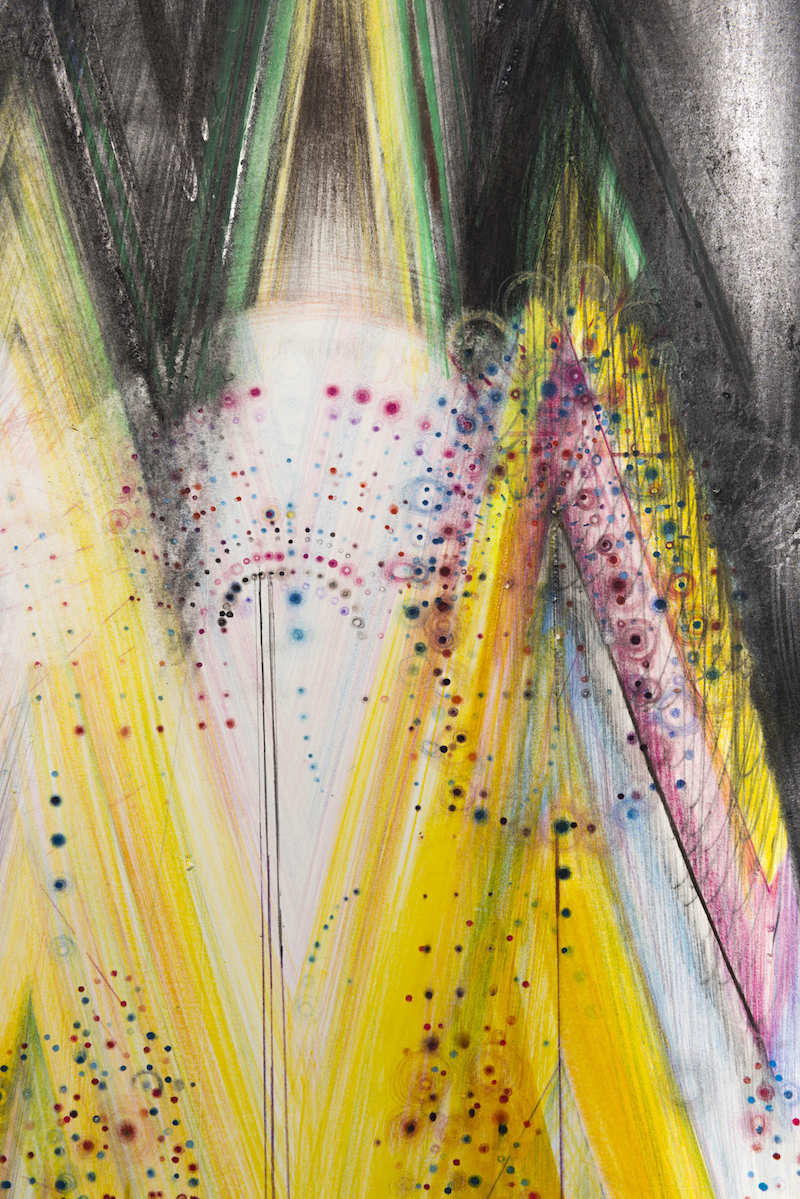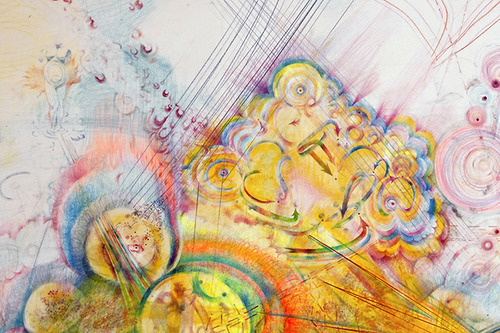
(When Stars Unfold Like Tents, 2011, Michelle Oosterbaan)*
I’m excited to introduce Michelle Oosterbaan, a talented artist and teacher who exemplifies a life devoted to creative practice. Michelle and I met in Walter Bartman’s art class at Walt Whitman High School in Bethesda, Maryland when we were 15. I was always impressed with Michelle’s creativity, her immense technical skill, her quiet intensity and her warmth. We lost touch after graduation, but we recently reconnected via Facebook. In the spirit of creative discovery coming full circle, I’m very happy to feature Michelle in the inaugural “Creative 20 Questions” interview that follows.
In this series, I will explore the diverse influences, processes, practices and insights of creative professionals from a range of fields. My hope is that these interviews will “pull back the curtain” on creativity, demystifying it and offering inspiration to people from all walks of life, including practicing and aspiring creative professionals; those who seek to nurture their everyday creativity; and educators, parents, caregivers and anyone else striving to spark and sustain lifelong creativity.

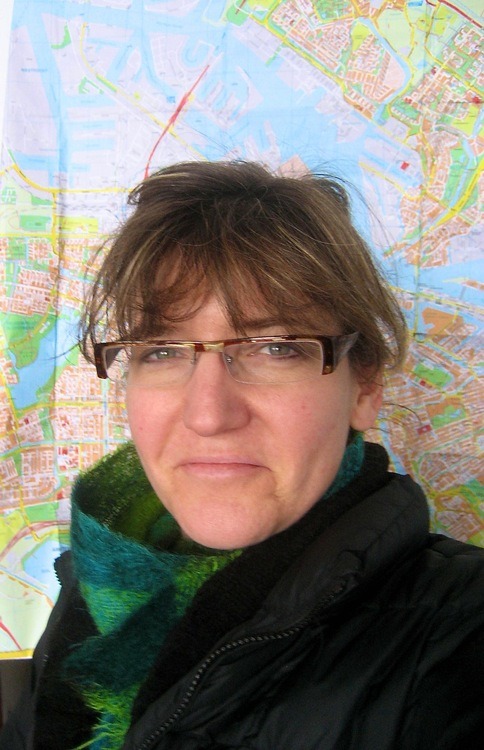
(Michelle Oosterbaan during her residency at M4 Studio, Amsterdam)
Meet Michelle
Michelle Oosterbaan is a visual artist who creates drawings and installations that explore “a sense of place and passage of time.” She has exhibited nationally and internationally at venues including theMuseum of Modern and Contemporary Art (Rijeke, Croatia), The Drawing Center, Weatherspoon Art Museum, the Pennsylvania Academy of Fine Art and Museum, The Contemporary Art Museum, St. Louis and Gallery Joe. Currently a Visiting Assistant Professor of Painting and Drawing at Bowdoin College in Brunswick, Maine, Michelle has previously taught at Bucknell University, Drew University,Drexel University, Washington University-St. Louis, the University of Pennsylvania, and Swarthmore College, among other institutions.
The vibrant, color-infused drawings and paintings that Michelle creates have tremendous energy. They spill off of the page and the canvas, sometimes moving beyond their frames and borders to enliven the spaces around them. Her works seek to evoke “the visceral experience of change – tracing stages of things falling apart and things coming together; pairing the unknown alongside the familiar.”
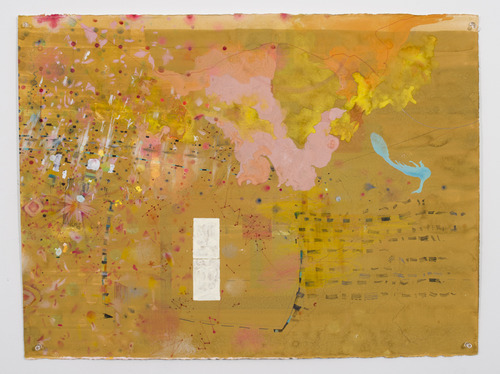
(Map, 2013, Michelle Oosterbaan)*
Michelle has embraced change and new vistas in her work and life through an impressive series of international residencies at Cite des Arts Internationale in Paris, M4 Studio in Amsterdam,DCRGueststudios in Den Hague, The Gil Society in Iceland, the MacDowell Colony and Yaddo, where she received the John D. & Catherine T. MacArthur Fellowship.
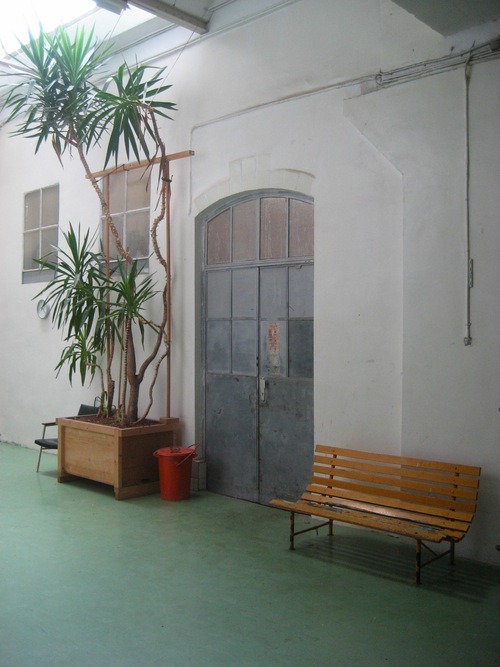
(The door to Michelle’s studio during her residency in Amsterdam)
Michelle’s “Creative 20 Questions” Interview follows.
Highly creative people often have diverse talents and interests. What labels do you use to describe yourself professionally and creatively? In what ways do you most enjoy exercising your creativity professionally or personally?
I call myself a visual artist.
What is your earliest memory of being creative or making something?
My mom tells me that I drew in nursery school during the breaks. I usually was alone and I made stacks of drawings about whatever I was thinking about. I also remember drawing with crayons on the white carpet on top of the stairs.
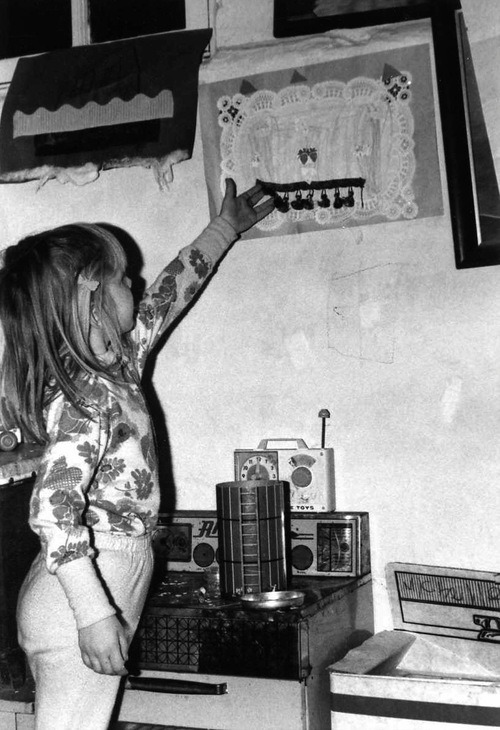
(Michelle as a child, displaying her early artwork)
How did you like to play as a young child? With whom? With what? Where?
I could entertain myself alone by drawing or coloring books or making things as a young child. But, I often played with construction trucks in the sandbox with the neighbors, with my sisters in the backyard making dolls from bark and moss scraps, or drawing with magic markers playing “What Am I Drawing?” in the back seat of the car. I also remember playing with color-stained wood boxes, making sofa forts with blankets and cushions in the basement, and helping my dad in the wood shop. I remember loving the smell of sawdust and the sound of a table saw blade.
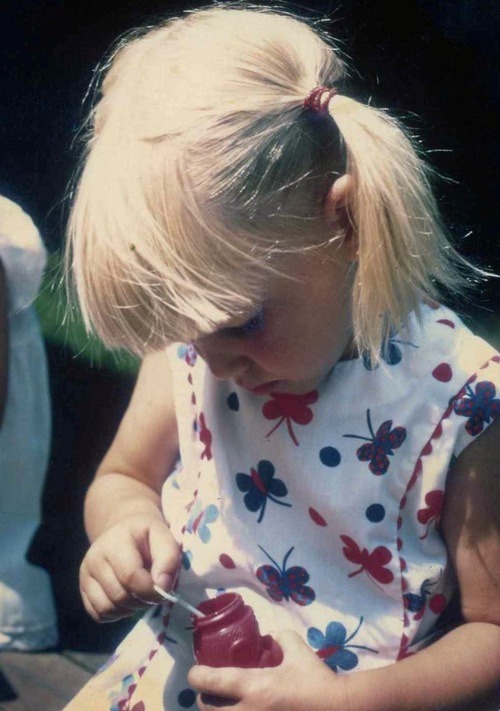
(Michelle as a young child, with bubbles)
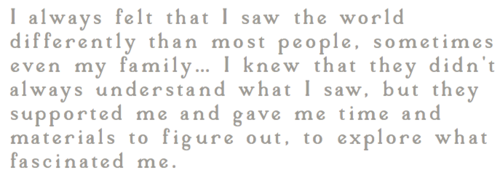
When and how did you know you wanted to be an artist?
I always felt that I saw the world differently than most people, sometimes even my family, which was pretty closely knit. I knew that they didn’t always understand what I saw, but they supported me and gave me time and materials to figure out, to explore what fascinated me, with weekly visits to the museums in town, going to concerts, buying art supplies, and buying me that crazy striped sweater. I think I always knew I that I am an artist, from being a small person. But, after painting for four years in high school, I knew definitely. Making art was something I had to actively pursue each day.
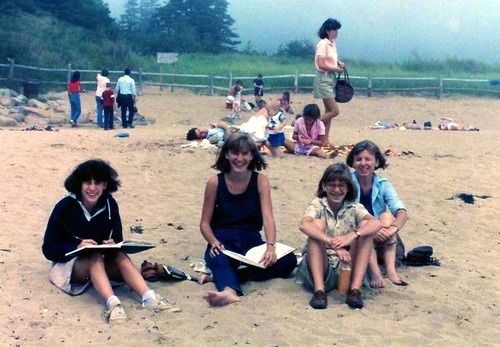
(Michelle during high school with her mother and sisters, sketching on a family trip to Maine)

What advice would you give to your younger self or to others about creativity and pursuing your field?
- Block out the commerce, the pressures and distractions of popular culture/ society. Make space for you to refine your skill and your art making practice.
- Make time for your craft. Practice, practice, practice. Put your time in each and every day. Practice long enough that you resolve an issue. I usually feel satisfied with 3–6 hours. 2 hours at minimum.
- Feed yourself. Give yourself an artist date every week or every month. Go get yourself to a new place, geographically or through a book or a movie or a phone call or a concert.
- Build a support system of artists you admire and trust.
- Apply to residencies to dedicate yourself to a project in a new place—it can provoke surprising results.
What are the greatest obstacles you had to overcome to become an artist or to stay an artist? What helped you get past them?
The greatest obstacle was earning a real living. And then once I could earn a living, preserving time for studio, so I was not working all the time to pay bills. And feeling unrecognized is a common feeling from early working artist days too.
Was there anyone in particular who you inspired you to be an artist or influenced your development as an artist?
I grew up living in Boston, Chicago, Detroit, and Washington DC. My family and my high school art teacher did motivate me and shape my artistic path.
My great grandfather came from northern Holland as a wood worker and became a farmer in Michigan. My father is pretty visual. As a civil engineer, he is constantly explaining how things work. He loves figuring out landscaping, efficient and ingenious furniture arrangements, carpentry. He designed additions to the houses my family grew up in inspired from green design. My mother plays the piano (classical music). She brought me to the cathedral to listen to organ music and concerts in and around Washington DC regularly. They both loved traveling and seeing new, unknown cultures, locally in drives to an orchard or hikes and nationally to camping in New Mexico and sponsoring my first trip to Italy as a sophomore in high school. They fostered that same interest in me today.
I remember hearing “Pachelbel’s Canon” and being really blown away. That and Aaron Copeland’s “Fanfare for the Common Man” moved me.
My high school art teacher Walter Bartman had a profound influence on my path to become an artist.
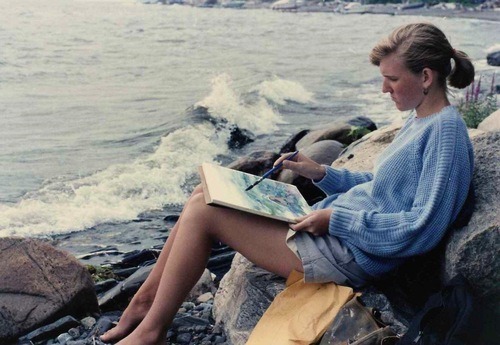
(Michelle during high school, doing a watercolor on a family vacation to Vermont)
Who or what currently inspires you?
A few of my inspirations include Dutch graphics, Swedish architecture, 16th century Belgian Tapestries, Chinese ink washes, Tibetan Mandelas, and Pina Bausch’s choreography. Contemporary artists that I find interesting include: Jessica Stockholder, Sarah Sze, Stefan Sagmeister, Julie Heffernan, Marian Bantjes, Jim Hodges, Kyle Staver and Julie Mehretu.
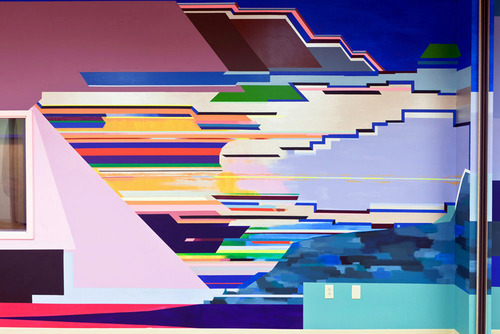
(Pulse: A Mixing Light Workshop: Collaboration with The Mural Arts Program of Philadelphia, 2010, Michelle Oosterbaan)*
What are you working on right now that you’re most excited about? What aspects of your creative work are you struggling with most right now?
I usually work on more than one piece at the same time. Usually about 5 going at once, mostly because I think in terms of scale and spatial relationships. So, I create a dialogue amongst the work as much as a narrative embedded in one piece. I enjoy painting for texture / mark making and mixing color to evoke color psychology. I love drawing because it is so immediate and intimate at once. And I make installations to activate my interest in architecture / sense of place / time / human body relationships.

(Current work in progress, gouache / paper / collage elements 2014)

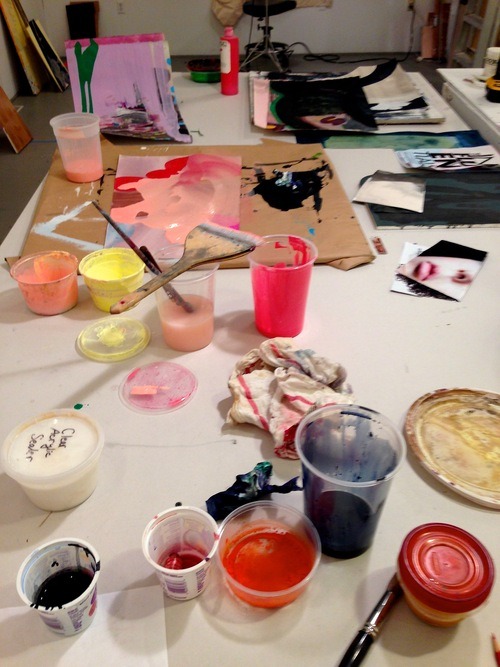
(Paints and brushes in Michelle’s studio)
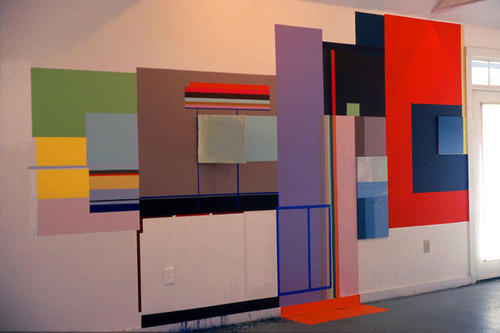
(June’s Swingin’ All Over, 2003, Michelle Oosterbaan)*
From time to time, I do have to corall my interests and chose one project to invest time and energy into. That is harder for me, but often proves valuable. For me, it is often a tug of war between process and product. I love making beautiful things, but equally love making a beautiful mess – love finding paths / narratives through, in, and around chaos, making sense of dense passages of information with a specific sense of touch, imagery, and dimension.
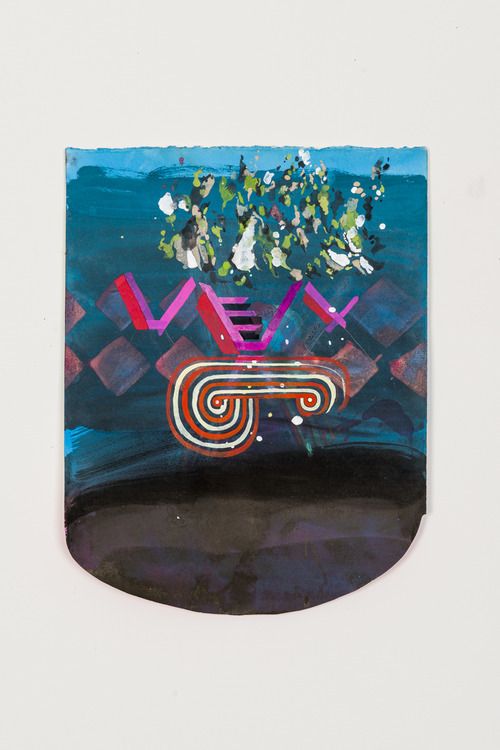
(NL DH, 2012, Michelle Oosterbaan)*
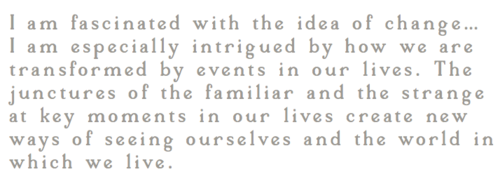
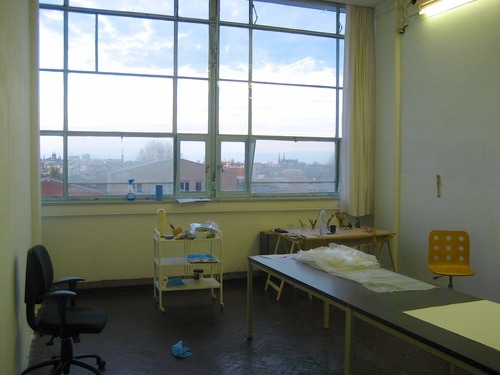
(Michelle’s Amsterdam studio)
Is there any consistency to your creative process from project to project? If so, what is your creative process like?
I am fascinated with the idea of change. In my work, I examine contradictions, tracing stages of things falling apart and things coming together. I like to analyze how transitions in time and place are simultaneously random and structured. I am especially intrigued by how we are transformed by events in our lives. The junctures of the familiar and the strange at key moments in our lives create new ways of seeing ourselves and the world in which we live. By examining color psychology, issues of scale, and symbolic mark making, my work describes the relationships between the human body / architecture and motion / stasis.
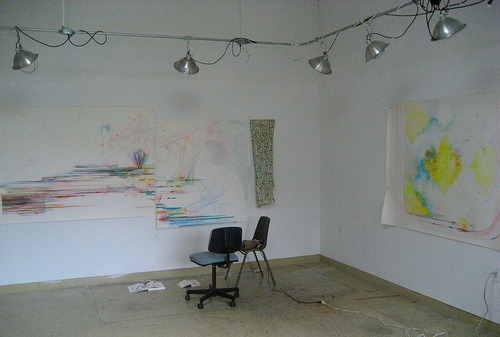
(Studio shot during the creation of “Amber Babes and Bedrock” at the Virginia Center for the Creative Arts)
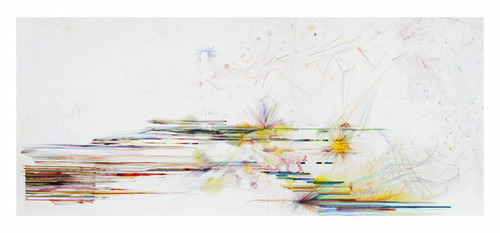
(Amber Babes and Bedrock, 2007, Michelle Oosterbaan)
My creative process is exactly that—it is really in flux. I do one thing, I do another thing to that, and do another thing to that. My process is sequential, I suppose that is obvious. Yet, I think of it as a construction, like time lapse photography. So my process builds on the previous action, each time not knowing really what will happen. And that keeps me chasing the mystery, keeps me in studio, figuring out how to best express my experiences, my memories with the world.

For example, my drawings are processed based. The very act of drawing guides my search to tell compelling stories. I draw, erase, redraw, erase, and then keep drawing from the erasure ghost images until I see a connection between mark and meaning. Stories evolve. Patterns in imagery cohere to build reference to landscape, architecture, and space in general. A sense of place, like an architecture of suggestion,takes hold.
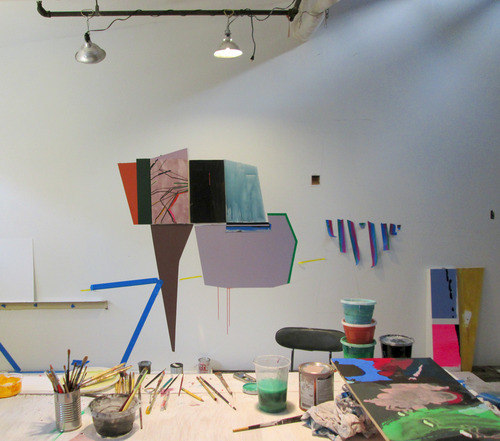
(Michelle’s Germantown studio)*
My drawings have evolved from the process of working on temporary wall paintings. They are maps. Built from networks of visions and renderings, I describe the confluence of order and chaos to highlight junctures of the familiar with the phantasmagorical.

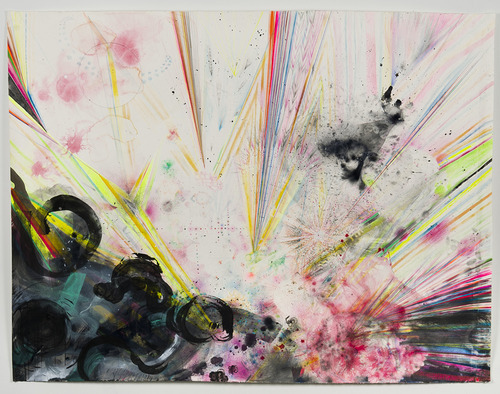
(Heliograph, 2012, Michelle Oosterbaan)*
Do you have a daily routine? What is it like?
On studio days I have coffee, try not to look at the computer until the evening to keep my mind fresh. I usually move – walk – in the mornings to feel the sun, take a “light walk” – remember the sensory – light, shadow, color, smells, sounds. I like to be physically in my studio all day long. Sometimes I just sit. Sometimes I visualize. Sometimes I look at books or read the paper until I know what move to make. It’s really important to be there 3 to 4 days a week for a complete day. So when I am not in studio, I can mull over ideas and return to studio with newer eyes.
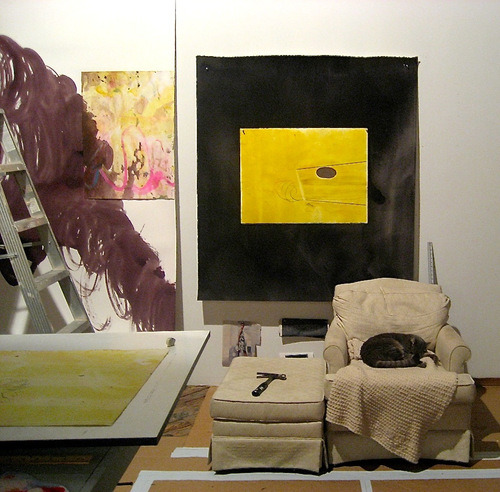
(Behind the scenes in Michelle’s studio, with a place to sit and reflect amidst the creative work)
What does it feel like when you are immersed in your work? Do you lose track of time? Has this ever caused problems in your life?
Yes! I do lose track of time. It is wonderful. All the “sweat” pays off in these moments. It is exactly likeMihaly Csikszentmihalyi states in his book Flow: The Psychology of Optimal Experience.
What do you do when you get stuck or blocked?
I get outside. I go to an art exhibit, concert; go to the library; I go see something else / new; I ask another painter friend for a studio visit.
What kind of environment do you like to work in?
My studio is sometimes obsessively organized down to where I put the thumbtacks or extremely messy with piles of stuff and collections of material. I love natural light. Skylights make all the difference in the world. I like big tables on wheels. I like having a place for tools, books, sketchbook drawing, a couch for daydreaming. I like to have visual clarity on one wall and a collection of images to prompt inspiration on another wall.
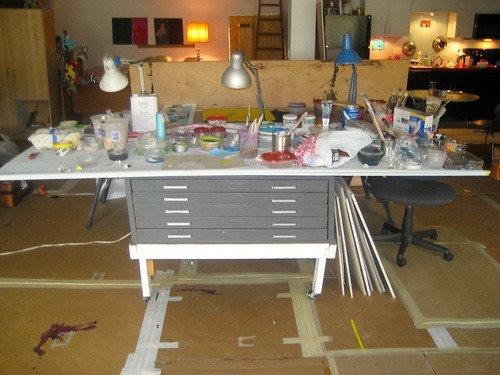
(Paint table workspace in Michelle’s studio with flat files on wheels)
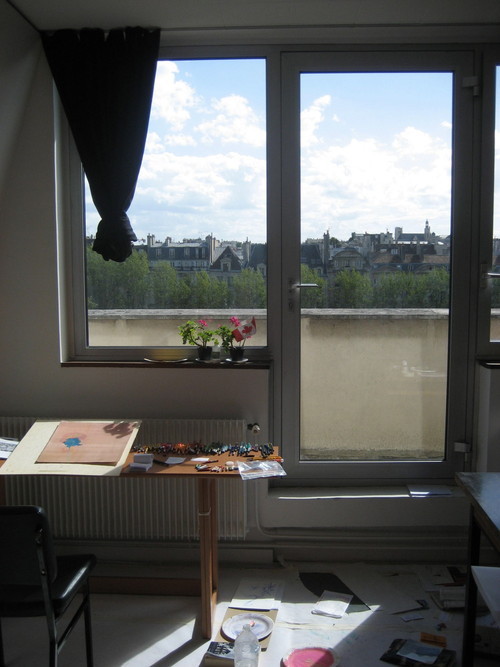
(Michelle’s Cite des Artes International Studio, Paris, France, 2009)*
What is your creative community like? How and under what circumstances do you collaborate with others or turn to others for creative support?
An artist’s creative community is super important. It helps to know people from different interests and expertise always. Even if it’s just to have help moving bigger pieces with a truck or finding out about a terrific show, community enhances my growth in unexpected and terrific ways.
What role do you play or have you played in teaching or mentoring others? What approaches do you find most effective in your teaching or mentoring?
Ever since graduate school, I have taught in college. I have taught Introduction to Drawing, Painting, Narrative and Conceptual Drawing, Map-Making in Art, Figure Drawing, Color Theory, and Design. Teaching / being around students creates a support system that is similar to creating an artistic community. It is exciting to teach. Younger artists are energetic and infuse the classroom with life. I teach using a sketchbook as a daily / weekly aid to figuring out what makes each student tick. It’s a great tool to record how a student’s interests and skills change and develop over the class time.
What are the greatest joys and the greatest hardships of doing this work?
The greatest joy is that I get to make stuff and talk to people about my vision. The greatest hardship is motivating through the inevitable highs and lows of creative inspiration… and moving big stuff!
What are the biggest misconceptions about your profession?
Perhaps, that artists are not necessary.

What would you be doing if you weren’t an artist?
I do not think that I could do anything else. I love being a visual artist and I am super grateful for all the interesting people I have met in this profession, those who have supported my vision and encouraged me to hone my talents and to do the thing that can be transformative for myself and, hopefully, for others who see the work.
Thank you, Michelle, for this glimpse into your creative world. To see more of Michelle Oosterbaan’s beautiful, evocative work, visit her website.
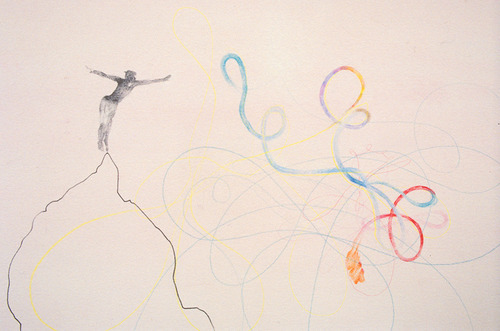
(Rockpool, 2006, Michelle Oosterbaan)*
*All photos courtesy of Michelle Oosterbaan and the Oosterbaan family.
